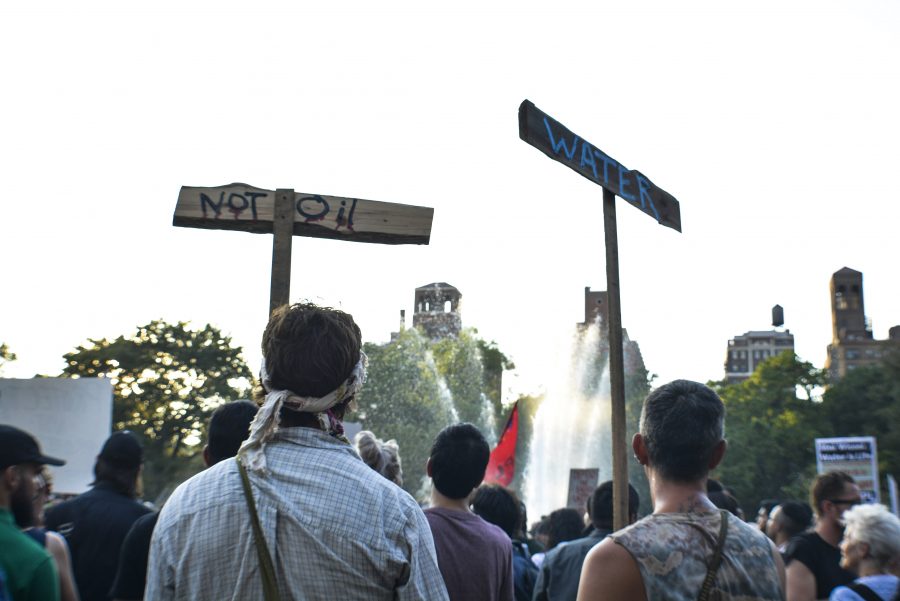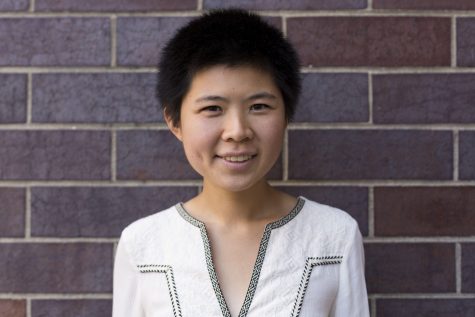Greenwich Village Stands Up for Standing Rock
Last Friday, a large crowd gathered in Washington Square Park to rally against the the Dakota Access Pipeline that would endanger the Standing Rock Sioux Tribe in North Dakota.
September 12, 2016
Speakers at the Rally for Standing Rock in Washington Square Park on Friday reminded the crowd that we all speak a foreign language: English. Repeatedly, they referenced to Manhattan as “Manhatta,” the name for the land before colonization, and they recounted stories of how Native Americans, over generations, have been evicted from the land they once occupied before settlers arrived.
The Dakota Access Pipeline is an underground pipeline for oil that would run near the Standing Rock Sioux Tribe’s reservation in North Dakota. People are angry about this development because oil pipes have a high risk of leaking and would endanger water quality and subsequently the well-being of surrounding people.
Department of Anthropology Ph.D Candidate Teresa Montoya hails from the Navajo nation, and she donned a T-shirt that said “Strong, Resilient, Indigenous.” She said that in the Navajo language, there is a saying that water is life, and they believe that water gives people strength.
“The question of Standing Rock is that if the pipeline goes through, it’s not if it’s going to spill, it’s about when,” Montoya said. “How many thousands and millions of people live on the water? This is not just an issue for native people — this is an issue for everyone.”
She said that she has been working with a group called Water is Life for the past year and that the people within the group identify themselves as protectors — not protesters.
New York City no Dakota Access Pipeline organized this peaceful rally, and all the members of the organization echoed the sentiment of being protectors. Anne Spice, one of the organizers and emcees of the event, said that the rally was a collaborative effort of indigenous scholars, activists and allies at CUNY, NYU, The New School, Columbia and people outside of academia.
“Together, we brainstormed actions,” Spice said. “We were busy putting together a ‘Standing Rock syllabus’ and organizing a teach-in at Columbia University when we got word of the violence (dogs and mace) unleashed on water protectors by private security in North Dakota. This crystallized our decision to hold a rally. Because the camps at Standing Rock have made it clear that they are not going anywhere, we wanted to send them winter supplies.”
She said that over 2,000 people were at the rally during its peak, and they collected over 10 bins of supplies to send to Standing Rock.
Executive Director of American Indian Community House Kevin Tarrant said that NYCnoDAPL contacted him to help lead songs and chants with his drum group.
“I think this is going to help with the awareness,” Tarrant said. “That’s basically what this — today — is about. We’re going to raise awareness, because most people who aren’t native or aren’t from the area don’t know what this is about.”
Spice said that the show of solidarity and support for the Oceti Sakowin (the proper name for the Sioux tribe) and for indigenous peoples across Turtle Island was deeply moving, and she said that she remains committed to indigenous sovereignty.
“I am inspired by the enactment of unity and indigenous resilience, and our group will continue to fight against the Dakota Access Pipeline until the project is destroyed,” Spice said. “It is our responsibility to do so, and we will continue to fight— for Standing Rock and for all those resisting the violent colonial encroachment of extractive industry.”
A version of this article appeared in the Monday, Sept. 12 print edition. Email Diamond Naga Siu at [email protected].

























































































































































